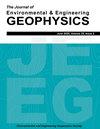奇异值分解(SVD)方法在地震资料反演中对浅层地震特征的改进——以墨西哥东北部某地为例
IF 0.7
4区 工程技术
Q4 ENGINEERING, GEOLOGICAL
引用次数: 1
摘要
地震资料反演可采用几种方法。然而,通常,这些方法无法区分垂直和水平异质性。奇异值分解(SVD)地震反演方法为这些传统反演模型的改进提供了一种充分而简便的方法。在这项研究中,在墨西哥东北部的一个地点获得了P波和S波的数据,得到了它们的传播时间。然后开发了一种涉及SVD分析的反演算法来建立岩性单元的地震速度。此外,还获得了纵波速度和横波速度(Vp和Vs)、Vp/ Vs比和弹性模量(体、剪切和杨氏模量、lam本文章由计算机程序翻译,如有差异,请以英文原文为准。
Improvement of Shallow Seismic Characterization Using the Singular Value Decomposition (SVD) Method in Seismic Data Inversion: A Case Study of a Site in Northeast Mexico
Several approaches can be taken to conduct seismic data inversion. However, usually, these approaches are unable to distinguish vertical and horizontal heterogeneities. Seismic inversion through the singular value decomposition (SVD) method offers an adequate and simple way to improve these traditional inversion models. For this study P and S wave data were acquired at a site located in northeastern Mexico, obtaining their travel times. An inversion algorithm involving the SVD analysis was then developed to establish the seismic velocities of the lithological units. Further, images of compressional and shear-wave velocities ( Vp and Vs, respectively), Vp/ Vs ratio, and elastic moduli (bulk, shear and Young's moduli, Lamé's constant, and Poisson's ratio) were obtained. These were compared with two geotechnical soundings positioned over a geophysical profile line. The geological features of the exposed units were recognized on some trenches. Further, seismic images demonstrated correlations with the thickness and distribution of the geological units. Unconsolidated sediments and fine-grain clastic rocks (in the Méndez formation) were clearly distinguished by the high velocity contrast. SVD seismic inversion has shown the ability to distinguish small physical heterogeneities of shallow geological units. Its application in civil engineering, hydrogeology, and to solve soil pollution problems can be relevant.
求助全文
通过发布文献求助,成功后即可免费获取论文全文。
去求助
来源期刊

Journal of Environmental and Engineering Geophysics
地学-地球化学与地球物理
CiteScore
2.70
自引率
0.00%
发文量
13
审稿时长
6 months
期刊介绍:
The JEEG (ISSN 1083-1363) is the peer-reviewed journal of the Environmental and Engineering Geophysical Society (EEGS). JEEG welcomes manuscripts on new developments in near-surface geophysics applied to environmental, engineering, and mining issues, as well as novel near-surface geophysics case histories and descriptions of new hardware aimed at the near-surface geophysics community.
 求助内容:
求助内容: 应助结果提醒方式:
应助结果提醒方式:


